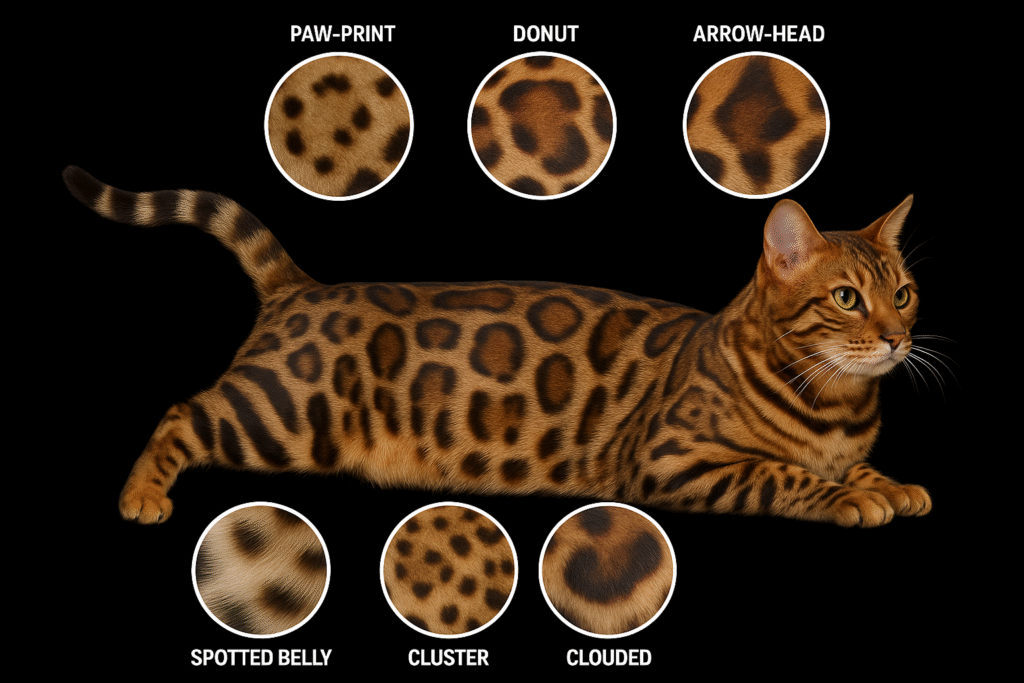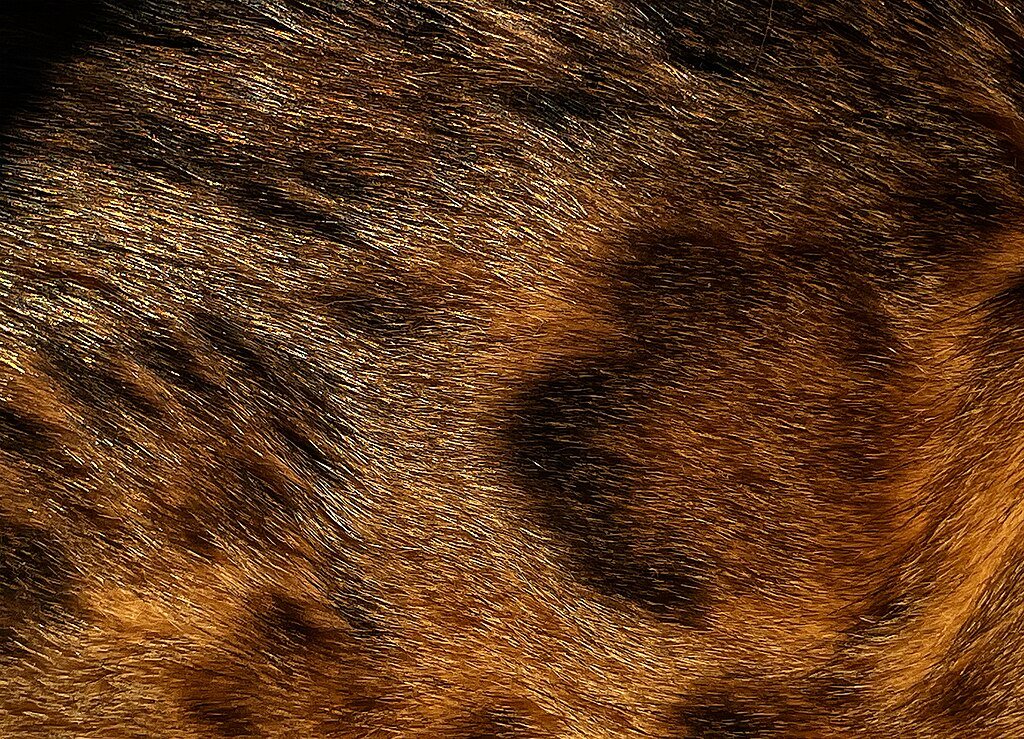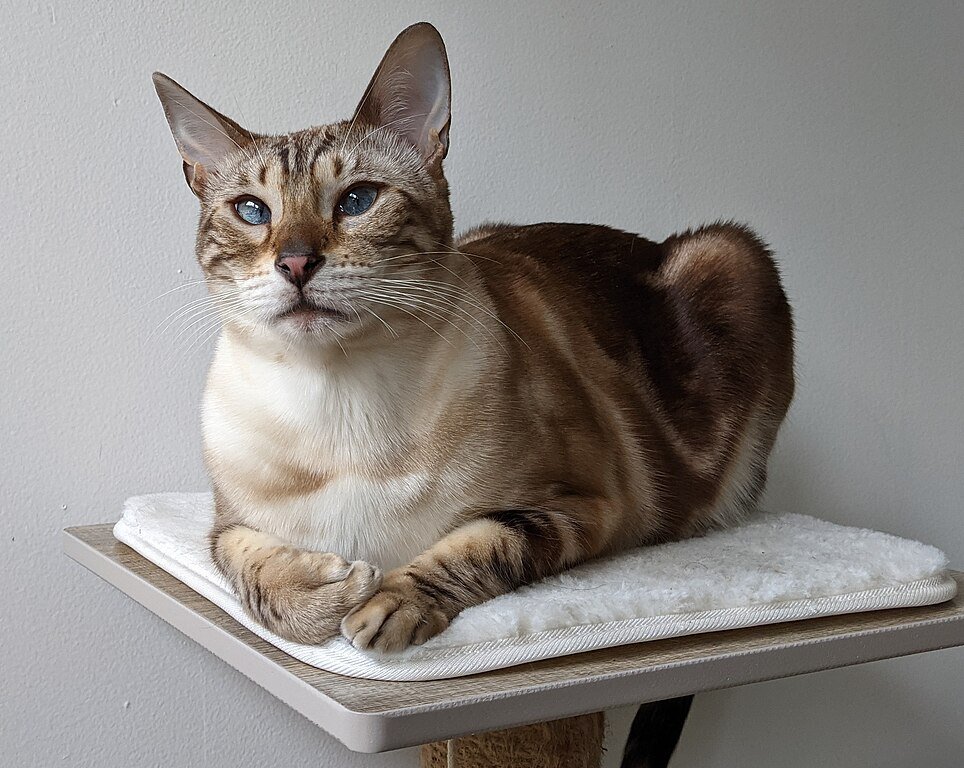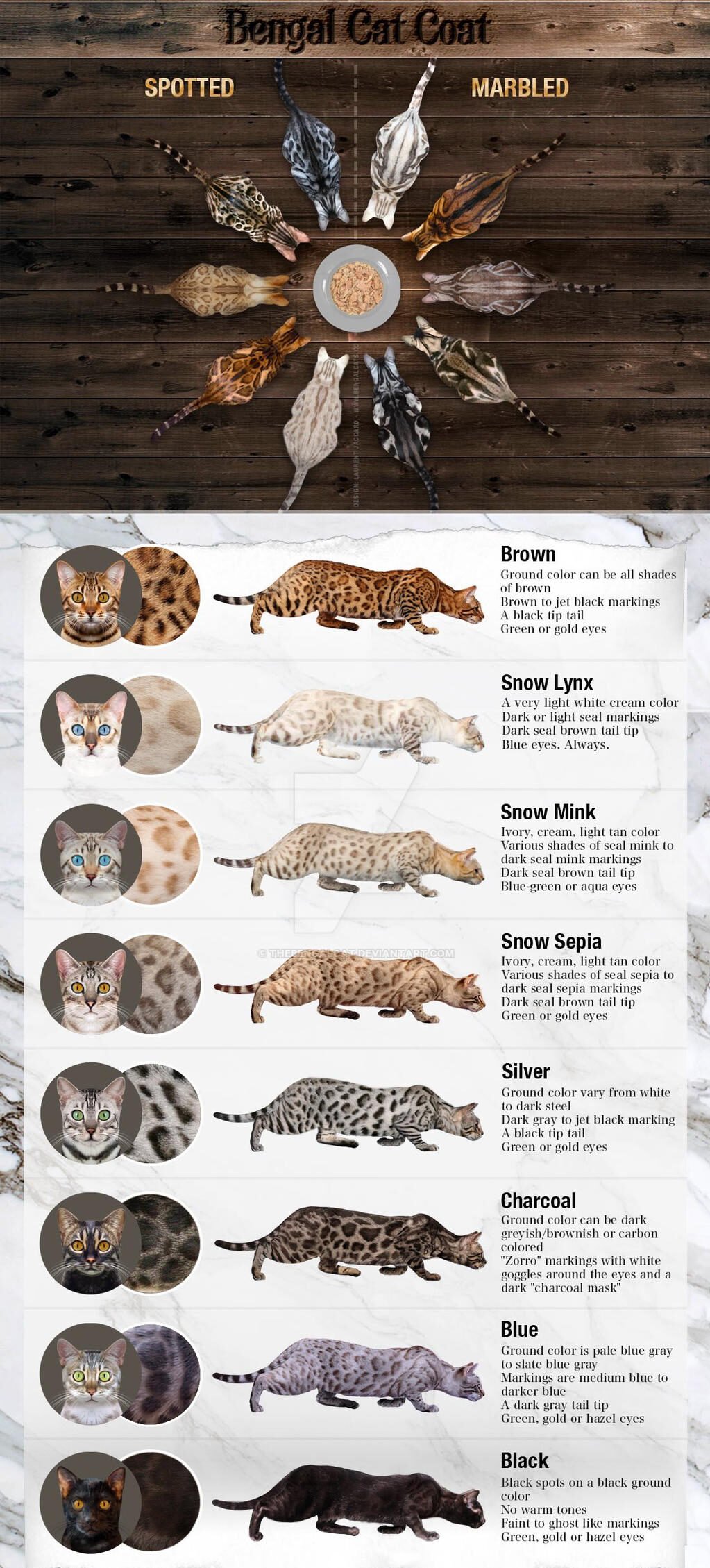When I first brought home my Bengal cat Raja, I was immediately mesmerized by his extraordinary coat. The intricate patterns, the striking contrast, and that unmistakable wild appearance that makes Bengal cats so unique. But I quickly realized that understanding Bengal coat genetics and terminology can feel like learning a new language! Over my many years of Bengal breeding and ownership, I’ve learned to appreciate the fascinating complexity behind these stunning felines.
Whether you’re a prospective Bengal owner, a new enthusiast, or simply an admirer of these magnificent cats, this comprehensive guide will help you understand the dazzling array of Bengal cat colors and patterns. We’ll explore everything from the basic terminology of spots and marbles to the mesmerizing “glitter” effect that makes these cats truly shine.
Introduction: The Artistry of the Bengal Coat
The Bengal cat’s coat is truly a living canvas—a beautiful remnant of their wild ancestry from the Asian leopard cat. Unlike many domestic cat breeds with simple solid or tabby patterns, the Bengal displays complex, wild-looking markings that reflect their exotic heritage.
What makes the Bengal coat so special is its incredible diversity combined with specific requirements for show quality. The perfect Bengal coat balances several key elements: pattern clarity, contrast between pattern and background color, and texture. When all these elements come together perfectly, the result is breathtaking.
I’ve spent countless hours at cat shows watching judges examine these elements with expert eyes. The difference between a pet-quality Bengal and a show-winning specimen often comes down to subtleties in pattern definition that the untrained eye might easily miss.
Today, we’ll break down these elements so you can develop that trained eye and truly appreciate what makes a Bengal’s coat special.
Understanding Basic Terminology: Spots vs. Marbles, Rosettes Explained
Before diving deeper, it’s essential to understand the fundamental terminology used to describe Bengal patterns. There are two primary pattern categories recognized in Bengals: spotted and marbled.
Spotted Patterns
The spotted pattern is what most people initially picture when thinking of Bengals—reminiscent of their wild leopard ancestors. However, not all spots are created equal:
- Single spots: Simple, solid spots of color. While acceptable, these are generally less desirable in show cats than rosettes.
- Rosettes: More complex patterning where spots have a distinct outline with a different color inside. These are highly prized and come in several variations.

Types of Rosettes
Rosettes are what give the Bengal coat that “wild” look, and they come in several distinct varieties:
- Donut/Arrow Head Rosettes: These feature a complete or partial circle of dark color surrounding a center of the background color. I often describe these to new Bengal owners as looking like “cheerios” on the cat’s coat.
- Paw Print Rosettes: These resemble a paw print with a central spot surrounded by smaller spots.
- Chain Rosettes: These appear as interconnected spots forming chain-like patterns across the coat.
- Cluster Rosettes: Multiple small spots grouped closely together.
In my breeding program, I’ve found that donut rosettes tend to be the most striking, especially when they have high contrast and clear definition. However, all types of rosettes can be beautiful when well-defined.
Marbled Patterns
The marbled pattern is the other major Bengal pattern category, featuring swirling, flowing lines rather than distinct spots:
- Classic Marble: Shows a distinct bullseye pattern on the side of the cat, similar to classic tabby patterns but with more dramatic contrast.
- Sheeted Marble: Features horizontal flowing patterns that create a sheet-like appearance across the body.
When I acquired my first marbled Bengal, Maya, many of my friends mistook her for a different breed entirely! The marbled pattern creates a dramatically different look from the spotted pattern but is equally beautiful when properly developed.
The “Glitter” Gene: What It Is and How to Spot It
One of the most magical features of some Bengal cats is the presence of “glitter”—a unique feature that makes their coat appear to sparkle or shimmer in the light. This effect is caused by a specific gene that creates hollow hair shafts that reflect light differently than normal fur.
How can you tell if a Bengal has glitter? Here’s what to look for:
- In natural light, the coat appears to have a golden or pearly sheen
- When you move your hand across the fur, it seems to “light up” from certain angles
- The effect is most visible when light hits the cat from the side

My Bengal Jasper has particularly strong glitter in his coat, and visitors often comment that he looks like he’s been dusted with gold. It’s an absolutely stunning effect, though it’s important to note that glitter isn’t required for show quality, and many excellent Bengals don’t have it.
Recognized Patterns: Spotted (Detailing Rosette Types)
The spotted pattern is what most people associate with Bengals, and it comes with specific criteria for show quality. In my experience judging Bengal shows, these are the key elements we look for in an exceptional spotted Bengal:
What Makes an Ideal Spotted Pattern
- Pattern Clarity: Each spot or rosette should be clearly defined, not blurry or bleeding into the background color.
- Pattern Alignment: Ideally, spots align horizontally across the body rather than in a random scattered arrangement.
- Size Consistency: While some variation is natural, the rosettes should be relatively consistent in size.
- Coverage: The pattern should continue fully down the sides without fading and extend onto the legs.
Different Rosette Expressions
As mentioned earlier, rosettes come in several varieties, each with its own charm:
- Donut Rosettes: The most prized pattern, featuring spots with darker outlines surrounding a center of background color.
- Arrowhead Rosettes: Triangular or arrow-shaped markings, often with one point directed toward the tail.
- Paw Print Rosettes: A central spot surrounded by smaller spots, creating a pattern reminiscent of a paw print.
I’ve noticed that rosette types often run in bloodlines. When I was selecting my breeding pair, I specifically chose parents with strong donut rosettes, as that pattern tends to be inherited reliably.
Recognized Patterns: Marbled (Classic vs. Sheeted)
The marbled pattern is the second major pattern category in Bengals. Instead of spots, marbled Bengals display flowing, swirled patterns that create a stunning, almost painted appearance.
Classic Marble
The classic marble pattern features:
- A distinct bullseye or target pattern visible on the side
- Bold, thick swirls with clear edges
- High contrast between the pattern color and background
Sheeted Marble
The sheeted marble pattern displays:
- Horizontal flowing lines that run parallel to the ground
- A stretched, flowing appearance that wraps around the body
- Often appears more chaotic than the classic marble
What I find fascinating about marbled Bengals is how dramatically different each cat can look, even within the same pattern category. My marbled Bengal, Luna, displays an incredible mixture of both classic and sheeted elements that creates a truly one-of-a-kind appearance.

When judging marble patterns, we look for flowing lines with minimal spotting or broken pattern elements. The ideal marble pattern should flow smoothly across the cat’s body with dramatic contrast and clear definition.
Standard Color: Brown
The brown Bengal is the original and most common color variety. Brown Bengals display black or dark brown markings on a background that ranges from light tan to rich, warm orange/brown tones.
What makes a truly exceptional brown Bengal is the rich, reddish-orange background color (often called “rufousing”) that creates striking contrast with the dark markings. In my years of showing Bengals, I’ve noticed that judges often favor this warm, rich background over cooler, more grayish tones.
Introduction to Other Recognized Colors
While brown may be the most common, Bengals come in a stunning array of colors, each with its own unique charm:
Snow Bengals
These feature pattern colors ranging from dark brown to light tan on various white to cream backgrounds. Snow Bengals come in three varieties: Seal Lynx Point, Seal Mink, and Seal Sepia, each with progressively more pattern contrast.
Silver Bengals
These stunning cats have black or dark gray patterns on a white to light gray background, creating a dramatic high-contrast appearance. The lack of any warm tones gives silver Bengals a striking, almost black-and-white newspaper print look.
Blue Bengals
These display diluted coloration with blue-gray patterns on a light gray or cream background. The effect is softer and more subtle than the standard brown pattern.
Charcoal Bengals
A newer color development featuring extremely dark mask, cape, and pattern elements on a typically brown background, creating dramatic contrast.
Importance of Contrast in Patterns
Whether spotted or marbled, one element remains crucial across all Bengal patterns: contrast. The level of contrast between the pattern color and the background color can make the difference between a stunning Bengal and one with a muddy, indistinct appearance.
Factors that contribute to excellent contrast include:
- Background Color: Ideally clear and even, without ticking or spots that disrupt the main pattern
- Pattern Definition: Sharp, well-defined edges to the pattern elements
- Color Intensity: Rich, deep colors in both the pattern and background
When I evaluate kittens in my breeding program, contrast is one of the first elements I assess. Even with perfect rosette formation, a Bengal with poor contrast will have a less impressive appearance overall.
One important note: contrast develops with age in Bengals. Many kittens that appear somewhat muddy at 8-12 weeks will develop significantly better contrast as they mature. My Bengal Milo had relatively poor contrast as a kitten, but by age two, his pattern had developed remarkable definition and clarity.

Visual Gallery: Implementing Linkable Content Ideas
Now that we’ve covered the technical aspects of Bengal patterns and colors, let’s put it all together with visual examples of the major combinations:
Brown Spotted Bengals
The classic Bengal look with dark brown to black spots or rosettes on a golden to light brown background.
Brown Marbled Bengals
Flowing, swirling patterns of dark brown to black on a golden to light brown background.
Snow Spotted Bengals
Various degrees of brown/tan markings on ivory to white backgrounds.
Silver Spotted Bengals
Dark gray to black rosettes on a silvery-white background.
Charcoal Bengal
Extremely dark mask and markings creating dramatic contrast.

Appreciating the Diversity
The Bengal cat’s coat is truly one of the wonders of the domestic cat world. From the intricate rosette patterns to the flowing marble swirls, from the classic brown to the striking silver and snow varieties, there’s a Bengal pattern to capture anyone’s heart.
What I’ve learned through my years with these magnificent cats is that while show standards and technical terminology are important, what matters most is finding the pattern that speaks to you personally. Whether you’re drawn to the wild look of prominent rosettes or the artistic flow of a marble pattern, there’s a Bengal whose coat will take your breath away.
If you’re considering adding a Bengal to your family, I encourage you to spend time observing different patterns and colors in person. Photographs, while beautiful, don’t always capture the true depth and complexity of these remarkable coats.
I hope this guide has helped you develop a deeper appreciation for the artistry of the Bengal coat. What’s your favorite Bengal pattern? I’d love to hear in the comments below!
Frequently Asked Questions
Q: What are the officially recognized Bengal patterns?
A: According to The International Cat Association (TICA) and Cat Fanciers’ Association (CFA), there are two officially recognized Bengal patterns: spotted and marbled. The spotted pattern includes various rosette formations (donut, arrowhead, paw print, etc.), while the marbled pattern includes classic and sheeted variations.
Q: Can you explain the different types of rosettes?
A: Bengal rosettes come in several varieties. Donut rosettes feature a complete or partial circle of dark color surrounding a center of background color. Arrowhead rosettes are triangular with one point typically directed toward the tail. Paw print rosettes have a central spot surrounded by smaller spots. Chain rosettes appear as interconnected spots forming chain-like patterns, while cluster rosettes are groups of small spots clustered together.
Q: Does the coat pattern affect a Bengal’s personality or health?
A: There is no scientific evidence suggesting that coat pattern directly affects a Bengal’s personality or health. Temperament is influenced by genetics, socialization, and individual personality, not coat pattern. Similarly, health issues common to Bengals occur across all pattern types. Always choose a responsible breeder who prioritizes health and temperament over appearance.
Q: What does the “glitter” coat actually look like?
A: The “glitter” effect in Bengal coats appears as a sparkling or shimmering quality in the fur, most visible when light hits the coat from certain angles. It creates an iridescent effect that makes the fur appear to be dusted with gold, pearl, or silver depending on the Bengal’s base color. This effect is caused by hollow hair shafts that reflect light differently than normal fur. Not all Bengals have glitter, and its intensity varies considerably among those that do.
Disclaimer: While I’ve shared information based on my experience and research, this article is for educational purposes only. For specific health concerns or breeding questions about your Bengal cat, always consult with a qualified veterinarian who specializes in feline care.









